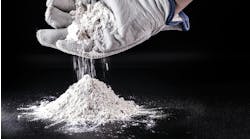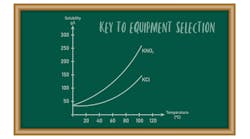The cornerstone of chemical engineering is based on the application of theoretical models and fundamentals. We have faith in these because they have been shown to be repeatable and, for the most part, infallible. We trust our theory will prove to match our real-world observations in practice. Otherwise, when we design a unit operation, how do you know what to expect?
But working with particulate solids opens many to challenge our faith in theory. Solids have too many degrees of freedom. We seldom work with one particle size but, instead, a distribution of not only size but shape and surface texture. An example is the treatment of slurries that usually appear as a dense liquid. This will satisfy energy and residence time concerns but not the interaction between the solids and settling characteristics.
I recall a slurry that appeared to be well-mixed as it came out of the crystallizer, but a subtle change in handling segregated the particles during centrifugation. In the original process design, the centrifuge processed the slurry as it came out of the crystallizer. To scale up the operation, more crystallizers were added. However, it was not possible to locate a centrifuge by each crystallizer. The designers decided to use a larger centrifuge in another building. This also allowed the process to be semi-continuous, which allowed the plant to be more efficient in response to customer demand.
Each crystallizer would discharge its slurry to the centrifuge feed tank. The system worked quite well until demand dropped. The feed tank had an agitator that only kept solids off the bottom of the tank. The centrifuge would produce larger particles at first and then finer particles later at low-crystallizer use. Some settling also occurred in the pipeline. The solution was to recirculate the slurry in the feed tank to avoid settling and tap off that line to run the centrifuge. In this case, the theory was correct, but it was not applied properly to account for the particle distribution.
Predicting the behavior of slurries is complicated by reactions and physical processes such as attrition. Friction or impact during handling may generate fine particles due to secondary nucleation. The fine particles are more reactive due to the increase in surface energy. This problem is noticeable in crystallizers, causing excessive nuclei that hinder growth and can give a different morphology to the crystals. We had a product with a very fast nucleation rate and generally made a mush-like slurry. However, after the size reached about 15 micron, nucleation dropped off, and growth increased. Theory would not predict this behavior, as crystallization is imagined as more of a continuous process. However, this is where seeding becomes an option if the meta-stable solubility range is reproducible. (Working with solids is a lot of fun.)
In theory, there are two major outcomes of attrition and a lot of gray areas between these two outcomes. One is the formation of only fine particles due to friction; the other is abrasion and breakage or splitting of the particles. Attrition seldom happens at these two extremes but exhibits a continuum of outcomes. To grind a chemical below the desired size requires repeated impacts and often produces more fine particles than desired. An elutriator could separate these fines but may require additional work before being salable. Why couldn’t we just break the size to our desired size?
The first answer I usually get focuses on the fundamental properties of hardness, elasticity/brittleness, Young’s modulus, as well as the undefined micro-cracks that allow breakage to occur along fault lines caused by chemical variations in the solid. An example is the crushing of coal. While the objective is to make the finer coal burn faster, the finest particles are those released along the fault lines and are the non-combustible components of coal (i.e., calcium, iron, ash.)
The second answer is that we really have no way to predict how a material will attrite based on physical properties. Instead, we must rely on experimentation and theories that relate energy used to the formation of surface area based on the elasticity theory of brittle solids (Kick, Bond, Rittinger.) There is a reason why the operators are always adjusting the fan on their hammer mill. The particles are constantly changing their physical properties.
There’s a saying that sums up working with solids: In theory, there is no difference between theory and practice; however, in practice, there is.



